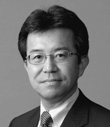| Pioneering Work on Arrayed-Waveguide Grating Based Wavelength Filters for WDM Optical Transmission Systems |
| Hiroshi Takahashi, Yasuyuki Inoue, Senichi Suzuki |
 Hiroshi Takahashi Hiroshi Takahashi |
 Yasuyuki Inoue Yasuyuki Inoue |
 Senichi Suzuki Senichi Suzuki |
@The award winners have devised a wavelength filter based on an arrayed-waveguide grating (AWG), which is a key optical device element for WDM optical transmission systems. The AWG can multiplex or demultiplex optical signals with multiple wavelengths simultaneously. They have proposed and studied AWGs using silica-based planar lightwave circuits since the early 1990s. The AWG, which is composed of multiple waveguides, works like a diffraction grating and separates optical signals with different wavelengths as shown in Fig. 1. Since the AWGs require very precise control of the phase of the optical signals, they are fabricated using integrated optical circuit technology. The high wavelength resolution characteristic of the AWG is relatively easy to realize by appropriate design of the optical paths in the waveguide array. Therefore, the AWGs are suitable for use as wavelength filters for high-density WDM optical transmission systems with optical channels using up to one hundred wavelengths where the channel spacing ranges from a few tens to a few hundreds of GHz. These specifications are difficult to realize using conventional bulk diffraction gratings or dielectric multilayer optical filters. The AWG is compact, suitable for mass production, and reliable. Furthermore, the large degree of flexibility as regards its circuit design makes it suitable for WDM applications with multichannel and arbitrary channel spacing. Because of these excellent features, the AWG has become an essential optical device in the progress on high-density WDM optical transmission systems that began in the late 1990s.

Fig. 1 Structure of AWG wavelength filter
@One of the award winnersf outstanding achievements was the first fabrication of a silica-based AWG on a silicon substrate. Moreover, they established AWG design theories and developed technologies for increasing the performance of the devices by achieving polarization-insensitive and thermal-insensitive characteristics. In addition, they have proposed optical wavelength selective switches incorporating an AWG and thermo-optic switches, and other functional integrated optical processing circuits. Many research institutes have followed their studies on AWGs and numerous research papers have been published on AWGs using optical materials other than silica-based glass, such as polymers, indium phosphide, and silicon. They have always been pioneers in the field of integrated optical circuits.

Fig. 2 Evolution of AWG-related research
@As described above, the award winners have proposed and realized AWG-based wavelength filters and contributed greatly to the advancement of WDM optical transmission systems. In addition, they have taken leadership roles in the field of integrated optical circuits. Their achievements are highly noteworthy and deserving of the IEICE Achievement Award.
(Q)@Y. Inoue, Y. Ohmori, M. Kawachi, S. Ando, T. Sawada, and H. Takahashi, “Polarization mode converter with polyimide half waveplate in silica-based planar lightwave circuits,” Photonics Technol. Lett., vol.6, pp.626-628, 1994.
(R)@H. Takahashi, S. Suzuki, and I. Nishi, “Wavelength multiplexer based on SiO2-Ta2O5 arrayed-waveguide grating,” J. Lightwave Technol., vol.12, pp.989-995, 1994.
(S)@H. Takahashi, K. Oda, H. Toba, and Y. Inoue, “Transmission characteristics of arrayed-waveguide N x N wavelength multiplexer,” J. Lightwave Technol., vol.13, pp.447-455, 1995.
(T)@S. Suzuki, A. Himeno, and M. Ishii, “Integrated multichannel optical wavelength selective switches incorporating an arrayed-waveguide grating multiplexer and thermooptic switches,” J. Lightwave Technol., vol.16, pp.650-655, 1998.
(U)@H. Takahashi, gRecent Progress on Silica-Based AWG Wavelength Multi/Demultiplexers,h IEICE Trans. on Electron., J86-C, pp491-499, 2003.
(V)@H. Takahashi, I. Nishi, and K. Kato, gMinister of International Trade and Industry National Invention Awardh, sponsored by Institute of Invention and Innovation, June. 2000.
(W)@H. Takahashi, Y. Inoue, and S. Suzuki, gIEICE Electronics Society Award,h Sept. 2010.